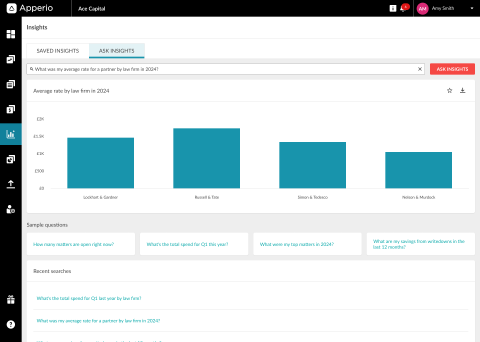Legal spend analytics that drive spend control and firm accountability in 2025

Legal teams aren’t short on data. But when it comes to managing outside counsel spend, most reporting is still backward-looking, summarizing costs after the fact rather than helping you stay in control as work progresses.
In a recent 2025 survey, 79% of legal departments reported pressure to reduce outside counsel costs, yet 57% said they don’t track or quantify savings, and nearly 60% still operate without formal billing guidelines. At the same time, 87% of teams spend four hours or less reviewing invoices each month, despite half believing they’re being overbilled.
That gap between intent and capability is exactly where legal spend analytics can add value.
In 2025, the most effective teams are tracking spend patterns as they unfold. They’re spotting issues early, like misaligned staffing or budget overruns, and using that insight to inform how matters are scoped, priced, and allocated.
This blog looks at the legal spend analytics that are helping teams do just that: maintain oversight, improve predictability, and hold firms to account.
What legal spend analytics need to deliver in 2025
Legal spend analytics should do more than document past spend. For teams focused on controlling costs and managing law firm performance, the priority is insight that supports intervention before issues escalate.
The most effective teams are moving beyond static dashboards and applying analytics that directly support how matters are staffed, scoped, and managed. This includes:
- Timekeeper-level granularity
Understanding who is doing the work is critical. High partner involvement on low-complexity tasks or excessive layering of timekeepers can drive unnecessary costs. Without detail at the timekeeper level, those trends go unchecked. - Budget accuracy by matter type and firm
Comparing forecast versus actual spend across similar matters can reveal recurring gaps in assumptions. Patterns here often point to misalignment in scoping, communication, or firm behavior, and inform where corrections are most needed. - Indicators embedded within live matters
Mid-matter visibility is becoming standard. If the billing cadence accelerates unexpectedly, staffing changes midstream, or budgets begin to drift, that data should be available in real time. This allows for in-matter adjustments instead of post-matter surprises. - Visibility across the full matter portfolio with the ability to investigate outliers
Legal leaders need to view spend at the portfolio level by region, business unit, or relationship, while still being able to dig into specific anomalies. Both perspectives are necessary to spot underlying drivers and improve control.
When analytics are tied to how work is managed in real time, they become a practical tool for staying on top of matters, questioning assumptions, and holding firms to the standards you’ve set.
Legal spend analytics that highlight early signs of misalignment
Legal spend rarely goes off course all at once. More often, it starts to drift. It might be a small change in staffing, a missed assumption, or a shift in billing pace. Legal spend analytics help teams catch these patterns early, while work is still underway and adjustments are still possible.
Here are the four types of legal spend analytics that help surface early signs of misalignment:
- Budget variance timing
A matter running 20% over budget at closing is one thing. A matter that’s 20% over after the first few weeks tells a different story. Tracking variance by phase or against burn rate expectations gives teams the ability to act early. - Inconsistent staffing models
If a firm typically uses two mid-level associates for a given type of work, but a new matter shows five timekeepers with overlapping roles, that inconsistency matters. It may signal unnecessary complexity, poor resourcing, or a lack of internal coordination—all of which drive costs. - Matter velocity and billing cadence
Unexpected changes in pace, whether delays in time entry or sudden surges in billing, can indicate scope creep, resourcing problems, or unanticipated rework. These issues often go unnoticed in high-level reporting but are visible when cadence is tracked consistently. - Low predictability by firm or matter type
When certain firms or matter types consistently go over or under budget, even when the work is scoped in a similar way, that’s a sign they’re harder to forecast. These patterns make it difficult to plan spend accurately and often indicate a need for tighter scoping, more structured pricing, or a change to fixed fees.
Individually, these signals may seem minor. Viewed together, they form a picture of how well a firm is delivering against expectations and how much control your team has in managing external work as it happens.

How leading teams operationalize legal spend analytics
High-performing teams embed these metrics into the way they manage firms, allocate budgets, and assess performance. The data isn't viewed in isolation. It’s part of a structured governance rhythm, reviewed alongside key financial and operational inputs.
Here’s what that looks like in practice:
|
Strategic objective |
Embedded practice |
|
Tighten matter-level accountability |
Weekly reviews of variance, staffing, and cadence with assigned budget owners |
|
Improve forecast accuracy across the portfolio |
Year-on-year comparison of budget vs actual by matter type, firm, and jurisdiction |
|
Strengthen panel relationships |
Quarterly reviews combining spend, staffing patterns, and outcome-based performance |
|
Control administrative overhead |
Reduction of rework and exceptions tracked by firm, feeding into billing compliance KPIs |
|
Enable smarter scoping and pricing decisions |
Historical staffing and cost data used to inform firm selection and pricing discussions |
In many cases, this work is supported by a dedicated legal operations lead, with input from finance and departmental budget owners. Clear roles and regular review points matter, especially when legal teams are working across multiple jurisdictions or business units.
Where these practices are most effective, analytics are integrated into existing routines rather than layered on top. That might mean a 15-minute monthly review per business unit, or a shared dashboard used in weekly check-ins with outside counsel.
From insight to impact: Closing the loop with legal spend analytics
Legal spend analytics only create value when they inform decisions. The most effective teams have built feedback loops that connect data to real decisions across budgeting, firm oversight, and matter management.
Spend data doesn’t sit in a silo. It informs how work is scoped at intake, how it’s staffed in progress, and how firm performance is assessed once complete. The same analytics that highlight a pattern of partner overuse can shape the way future work is resourced. A consistent budget overrun on a certain matter type can trigger a change in pricing strategy or firm selection. Repeated billing adjustments might prompt a shift in guidelines or panel composition.
Analytics aren’t the endpoint. They feed back into how legal work is planned, delivered, and evaluated.
And the teams that treat legal spend analytics as operational infrastructure, rather than after-the-fact reporting, are the ones seeing the biggest gains in cost control, predictability, and value from their outside counsel relationships.
If you're reviewing how analytics fit into your own legal operations, it may be time to move beyond dashboards and start putting the data to work.
Connecting insight to action with Apperio and PERSUIT
Legal spend analytics are most powerful when they’re part of an end-to-end workflow, from the moment a matter is scoped to the point where performance is reviewed and future work is allocated.
Apperio and PERSUIT support that full cycle.
Apperio gives in-house teams the visibility they need to track in-progress spend, spot inefficiencies early, and understand billing behavior over time. PERSUIT builds on that insight by enabling smarter firm selection, clearer scoping, and more strategic pricing—helping legal and finance teams act on the data they’re already capturing.
Together, they create a feedback loop where spend management becomes continuous, not reactive, and where firm accountability is built into the way legal work gets done.
If you’d like to see what this looks like in practice, we’d be happy to show you. Get in touch to book a demo.

Source: https://www.legalbillreview.com/blog/2025-legal-spend-survey-results